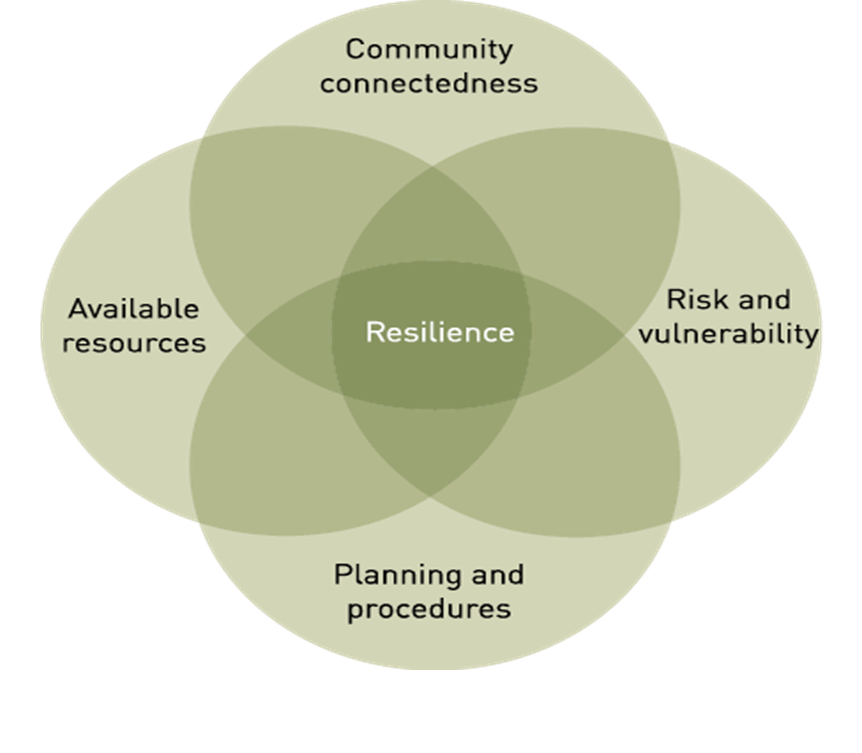You are here
- Home
- Blogs
- Anonymous's blog
- Strengthening resilience for a more sustainable future
Strengthening resilience for a more sustainable future
This is the second blog in a three part series by Visiting Fellow, Dr Helen Britton
It asks the question: How can I strengthen my resilience beyond a survival capacity to make my organisation more sustainable. By making several suggestions, it highlights the need to orient our thinking and to recognise the interconnected elements of building a resilience mindset. Resilience is ‘the art of thriving’. It is our ability to withstand, adapt and accelerate our responses to crisis, shocks and disruptions. Increasing the knowledge base of factors that influence sustainable practice are central to strengthening the resilience of our organisations.

In their White Paper (January 2023), ‘The World Economic Forum’ highlighted the importance for leaders of recognising the need to invest in long-term, sustainable and inclusive resilience measures. It was a loud call to action. There are many issues that have become more pronounced, post-pandemic, that will not only undermine our sustainability going forwards but our levels of resilience to be able to address them. This includes shortages in labour and increasing levels of gaps in skills across all sectors. As crisis and disruptions accelerate, the dynamics of organisations are changing rapidly. A key problem for many organisations is that they have failed to embed leadership creation throughout their practice. One of the consequences is that they lack much needed leadership capabilities to successfully address these dynamics of change now and for the future.
Embed resilience thinking within your organisation
A sustainable and resilience mindset starts from the position of being committed to what you do and who you do it for. Central to this is having a strong understanding of your market, your services; your clients’ needs, your risks and vulnerabilities, and your resources both inside and outside your organisation. This includes examining how connected you are within the community and beyond. Central to this are the roles and responsibilities of everyone associated with what you do. Any business strategy, in any organisation, in any sector, needs to invest in people to build resilience through retention and collaboration.
All organisations, at some point in their business cycle, will need to calibrate their direction: a clear perspective that is appropriate to that organisation’s aims and objectives. This could be a question of ‘fine-tuning’; or it could be to explore a more radical transformation of its services and how it delivers them. None of this can happen without quality leadership; able to match people’s talents to strategy.

Fact. The labour market is in ‘freefall’ and the migratory element of the labour market is simply not ‘filling the gaps’ and shortages pre-pandemic. This is affecting all sectors. I hear it all the time from my colleagues and family members who work in the NHS, private, public and non-profit organisations. I know firsthand how difficult this can make sustaining and growing a business. It facilitates uncertainty, undermines sustainability and ultimately weakens your personal and business resilience. This is an unsustainable position for all sectors going forward.
Be bold. Be brave. Be prepared to consider a spectrum of responses – from the more radical decision-making, if necessary, to very specific areas of action. Never under-estimate the potential for the impact of small, incremental, targeted changes – they could make all the difference. All require careful orchestration and involvement; everyone needs to be committed to make it happen. This is a collective endeavour and the capacity to do this effectively, and sustainably, needs to be developed. Ask yourself key questions regarding the needs of your business going forward and examine the staffing needed to deliver those requirements. Remember, it takes time to build and apply new skills-sets as people must have time to assimilate them into their practice. This needs to be planned for into the business timeline. Developing a culture of continuous learning – remember the mantra ‘lifelong learning’, it’s still there.
One of the primary pitfalls, in any organisation, is misunderstanding and incomprehension. Communication is an essential tool of all sector organisations. It is central to building and maintaining strong, working relationships at all levels. The forms in which we communicate has changed over the past few years and we have had to make some significant adjustments to how we work on a level not previously experienced. The notion of hybridised ways of working - in-person and remote - is now part of the ‘new normal’ as they become embedded in practice. If it works for your organisation, and your employees, embrace it. There is always going to have to be a compromise but remember to keep the focus on resilience and sustainability in mind. Offering it as part of a role, may just make the difference between recruiting and retaining staff.
Most of us have experienced a ‘love-hate’ relationship with technology. I know I have, and especially when it is part of what we must embrace; often with insufficient time and targeted instruction to develop the skills to apply and use it effectively. The reality is, let’s face it, most of us are using tech and artificial intelligence (A.I.) in some aspect of our lives. Rather than fear technology, investigate how it could work better for you, your clients, your staff. If you don’t feel you have enough expertise within your business, research where you can gain that additional knowledge for further training. Courses themselves can be delivered remotely in more ‘bite-size’, not-so-time intense ways to work with you. Check out The Open University’s fantastic ‘OpenLearn’ platform of free learning courses from introductory to advanced. Find out if you have local companies who can meet your needs or you theirs. There could be the potential for some interesting collaborations you hadn’t previously considered. Supporting local organisations is then feeding into the overall sustainability of the fabric of the local non-profit and for-profit business community. Often, organisations are surprised to learn who is trading in different fields in their own areas, and the range of skills and services they offer.
Finally, in re-thinking and re-orientating, should we also re-consider some of our business approaches? Sticking with past ‘ways of doing’ may not serve us well enough for the now and in the future. We need to plan to mitigate, as best we can, the extent to which any future change impacts our organisations (and ourselves). Resilience and sustainability thinking needs to be woven into our internal coding from the outset.
Coming soon!
Helen's next blog (3 of 3) in this series, explores the idea of sustainability credentials.
Read Helen's first blog in this series here with a specific focus on exploring the environment around the not-for-profit (NFP) sector and the challenges it presents for sustainability.
31st October 2023


